Case Study: Vital Sign Measurement and Intervention Strategies
VerifiedAdded on 2021/06/15
|9
|2221
|404
Practical Assignment
AI Summary
This assignment presents a case study involving a 63-year-old patient, Rosy Smith, who experiences hypothermia after swimming in cold water. The assignment analyzes the patient's subjective and objective cues, including shivering, cold extremities, and abnormal vital signs such as high blood pressure, a weak pulse, and a low body temperature. The analysis categorizes these cues, compares them to previous records, and diagnoses hypothermia. The assignment explains the physiological mechanisms of hypothermia and the body's response to cold stress. It then details intervention strategies, including moving the patient to a warm environment, removing wet clothing, and providing warm drinks. Furthermore, the assignment includes a reflection on the student's experience, emphasizing the importance of patient autonomy and dignity when taking vital signs, and highlights the ethical considerations of nursing practice. The assignment concludes with a discussion of the student's learning and future actions.
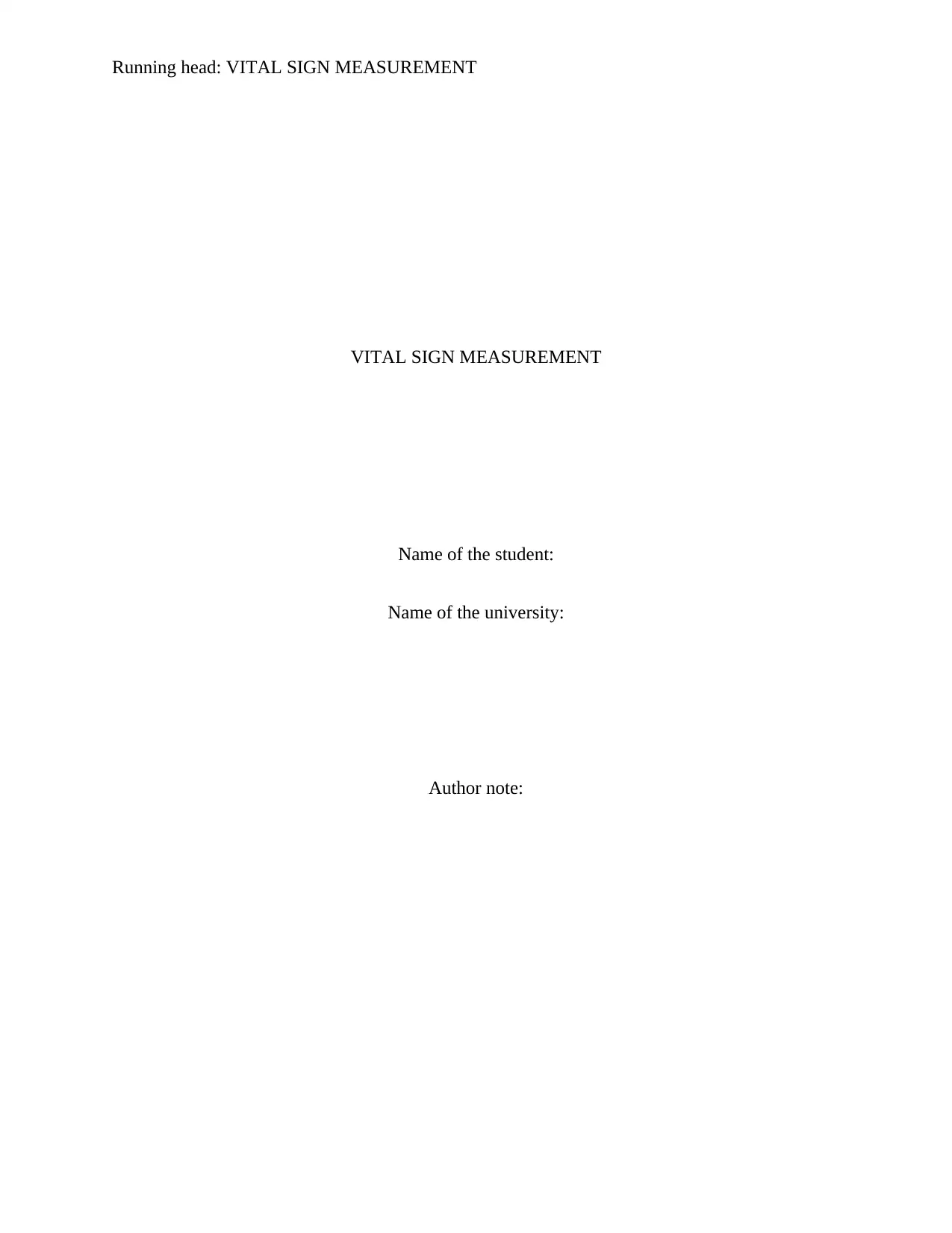
Running head: VITAL SIGN MEASUREMENT
VITAL SIGN MEASUREMENT
Name of the student:
Name of the university:
Author note:
VITAL SIGN MEASUREMENT
Name of the student:
Name of the university:
Author note:
Paraphrase This Document
Need a fresh take? Get an instant paraphrase of this document with our AI Paraphraser
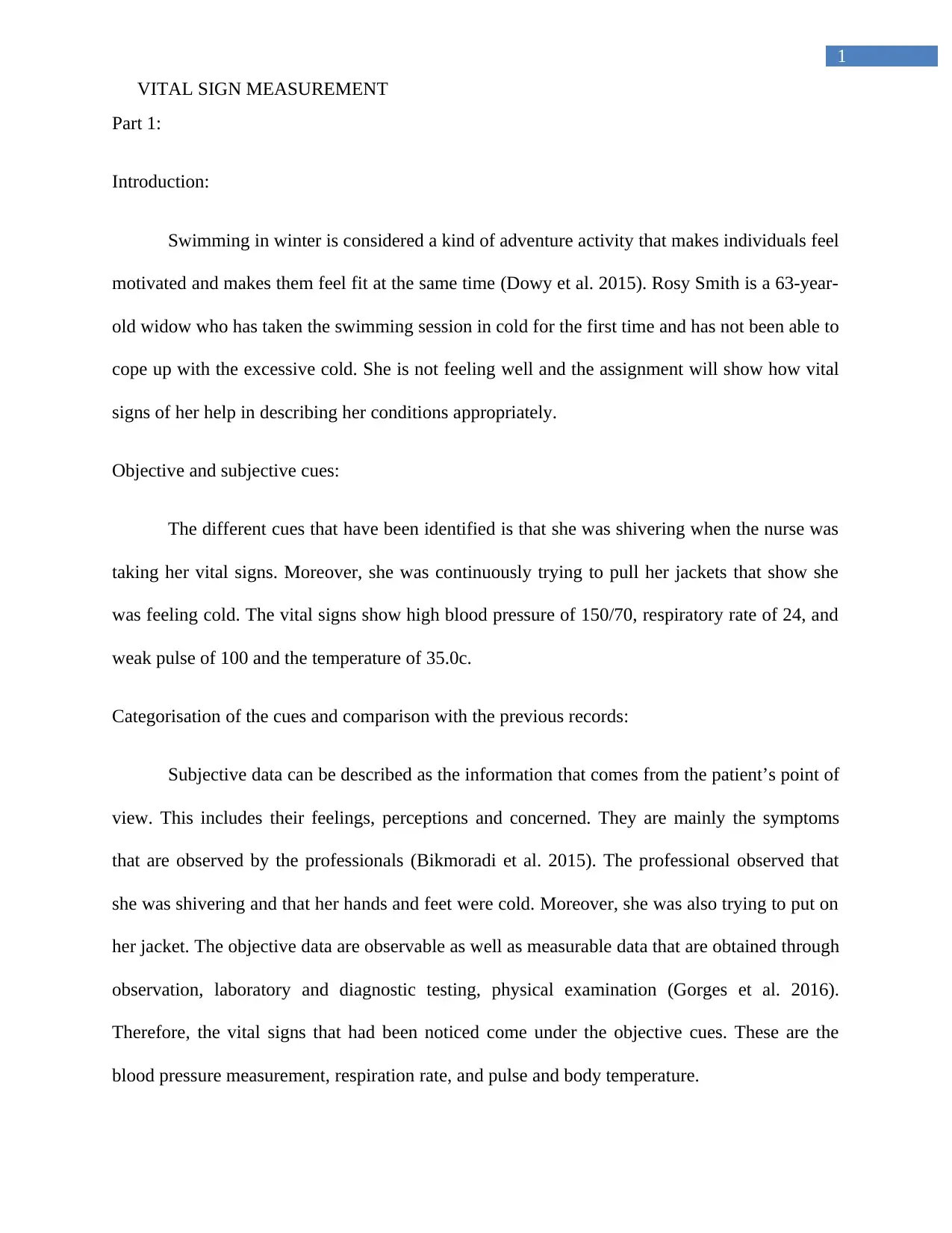
1
VITAL SIGN MEASUREMENT
Part 1:
Introduction:
Swimming in winter is considered a kind of adventure activity that makes individuals feel
motivated and makes them feel fit at the same time (Dowy et al. 2015). Rosy Smith is a 63-year-
old widow who has taken the swimming session in cold for the first time and has not been able to
cope up with the excessive cold. She is not feeling well and the assignment will show how vital
signs of her help in describing her conditions appropriately.
Objective and subjective cues:
The different cues that have been identified is that she was shivering when the nurse was
taking her vital signs. Moreover, she was continuously trying to pull her jackets that show she
was feeling cold. The vital signs show high blood pressure of 150/70, respiratory rate of 24, and
weak pulse of 100 and the temperature of 35.0c.
Categorisation of the cues and comparison with the previous records:
Subjective data can be described as the information that comes from the patient’s point of
view. This includes their feelings, perceptions and concerned. They are mainly the symptoms
that are observed by the professionals (Bikmoradi et al. 2015). The professional observed that
she was shivering and that her hands and feet were cold. Moreover, she was also trying to put on
her jacket. The objective data are observable as well as measurable data that are obtained through
observation, laboratory and diagnostic testing, physical examination (Gorges et al. 2016).
Therefore, the vital signs that had been noticed come under the objective cues. These are the
blood pressure measurement, respiration rate, and pulse and body temperature.
VITAL SIGN MEASUREMENT
Part 1:
Introduction:
Swimming in winter is considered a kind of adventure activity that makes individuals feel
motivated and makes them feel fit at the same time (Dowy et al. 2015). Rosy Smith is a 63-year-
old widow who has taken the swimming session in cold for the first time and has not been able to
cope up with the excessive cold. She is not feeling well and the assignment will show how vital
signs of her help in describing her conditions appropriately.
Objective and subjective cues:
The different cues that have been identified is that she was shivering when the nurse was
taking her vital signs. Moreover, she was continuously trying to pull her jackets that show she
was feeling cold. The vital signs show high blood pressure of 150/70, respiratory rate of 24, and
weak pulse of 100 and the temperature of 35.0c.
Categorisation of the cues and comparison with the previous records:
Subjective data can be described as the information that comes from the patient’s point of
view. This includes their feelings, perceptions and concerned. They are mainly the symptoms
that are observed by the professionals (Bikmoradi et al. 2015). The professional observed that
she was shivering and that her hands and feet were cold. Moreover, she was also trying to put on
her jacket. The objective data are observable as well as measurable data that are obtained through
observation, laboratory and diagnostic testing, physical examination (Gorges et al. 2016).
Therefore, the vital signs that had been noticed come under the objective cues. These are the
blood pressure measurement, respiration rate, and pulse and body temperature.
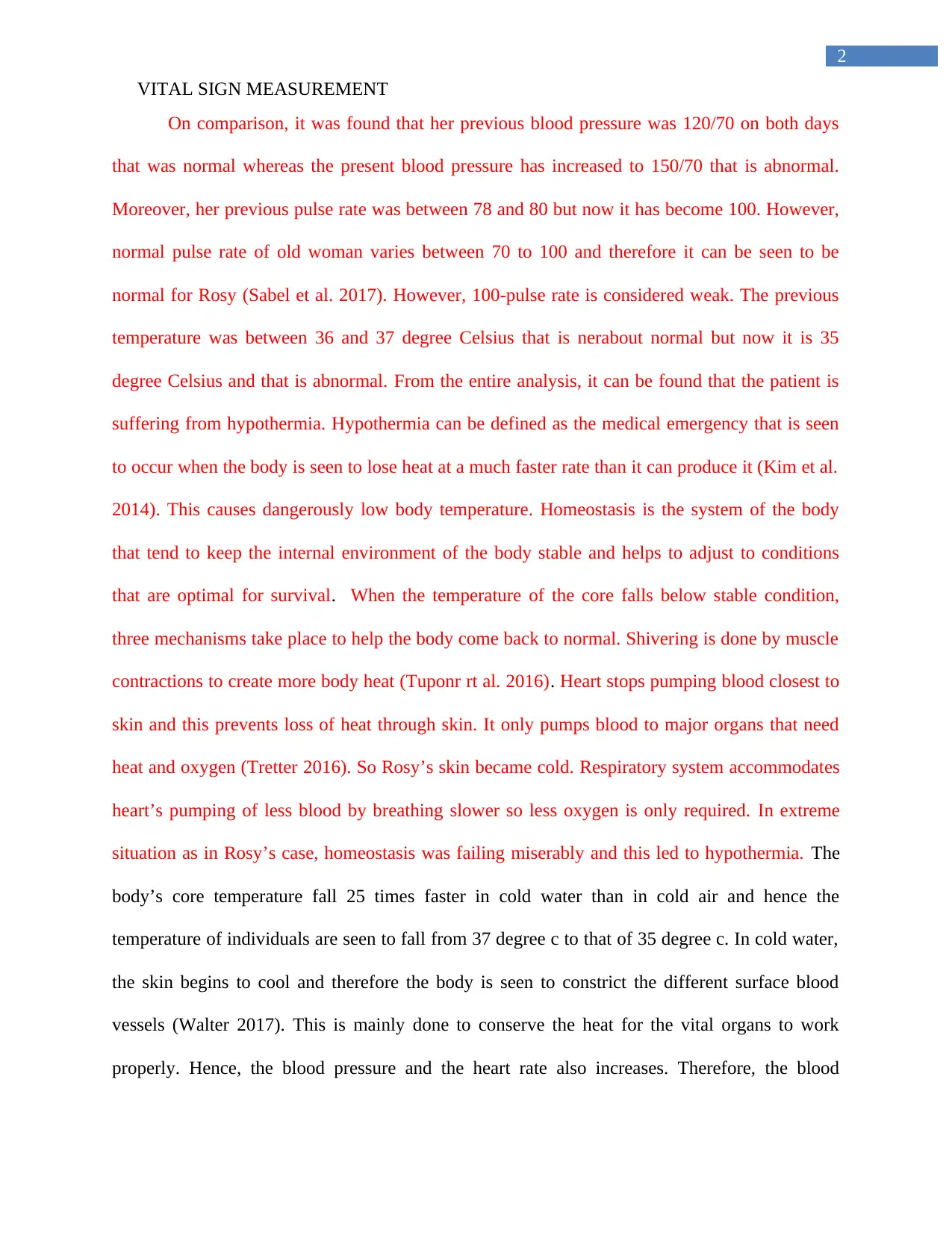
2
VITAL SIGN MEASUREMENT
On comparison, it was found that her previous blood pressure was 120/70 on both days
that was normal whereas the present blood pressure has increased to 150/70 that is abnormal.
Moreover, her previous pulse rate was between 78 and 80 but now it has become 100. However,
normal pulse rate of old woman varies between 70 to 100 and therefore it can be seen to be
normal for Rosy (Sabel et al. 2017). However, 100-pulse rate is considered weak. The previous
temperature was between 36 and 37 degree Celsius that is nerabout normal but now it is 35
degree Celsius and that is abnormal. From the entire analysis, it can be found that the patient is
suffering from hypothermia. Hypothermia can be defined as the medical emergency that is seen
to occur when the body is seen to lose heat at a much faster rate than it can produce it (Kim et al.
2014). This causes dangerously low body temperature. Homeostasis is the system of the body
that tend to keep the internal environment of the body stable and helps to adjust to conditions
that are optimal for survival. When the temperature of the core falls below stable condition,
three mechanisms take place to help the body come back to normal. Shivering is done by muscle
contractions to create more body heat (Tuponr rt al. 2016). Heart stops pumping blood closest to
skin and this prevents loss of heat through skin. It only pumps blood to major organs that need
heat and oxygen (Tretter 2016). So Rosy’s skin became cold. Respiratory system accommodates
heart’s pumping of less blood by breathing slower so less oxygen is only required. In extreme
situation as in Rosy’s case, homeostasis was failing miserably and this led to hypothermia. The
body’s core temperature fall 25 times faster in cold water than in cold air and hence the
temperature of individuals are seen to fall from 37 degree c to that of 35 degree c. In cold water,
the skin begins to cool and therefore the body is seen to constrict the different surface blood
vessels (Walter 2017). This is mainly done to conserve the heat for the vital organs to work
properly. Hence, the blood pressure and the heart rate also increases. Therefore, the blood
VITAL SIGN MEASUREMENT
On comparison, it was found that her previous blood pressure was 120/70 on both days
that was normal whereas the present blood pressure has increased to 150/70 that is abnormal.
Moreover, her previous pulse rate was between 78 and 80 but now it has become 100. However,
normal pulse rate of old woman varies between 70 to 100 and therefore it can be seen to be
normal for Rosy (Sabel et al. 2017). However, 100-pulse rate is considered weak. The previous
temperature was between 36 and 37 degree Celsius that is nerabout normal but now it is 35
degree Celsius and that is abnormal. From the entire analysis, it can be found that the patient is
suffering from hypothermia. Hypothermia can be defined as the medical emergency that is seen
to occur when the body is seen to lose heat at a much faster rate than it can produce it (Kim et al.
2014). This causes dangerously low body temperature. Homeostasis is the system of the body
that tend to keep the internal environment of the body stable and helps to adjust to conditions
that are optimal for survival. When the temperature of the core falls below stable condition,
three mechanisms take place to help the body come back to normal. Shivering is done by muscle
contractions to create more body heat (Tuponr rt al. 2016). Heart stops pumping blood closest to
skin and this prevents loss of heat through skin. It only pumps blood to major organs that need
heat and oxygen (Tretter 2016). So Rosy’s skin became cold. Respiratory system accommodates
heart’s pumping of less blood by breathing slower so less oxygen is only required. In extreme
situation as in Rosy’s case, homeostasis was failing miserably and this led to hypothermia. The
body’s core temperature fall 25 times faster in cold water than in cold air and hence the
temperature of individuals are seen to fall from 37 degree c to that of 35 degree c. In cold water,
the skin begins to cool and therefore the body is seen to constrict the different surface blood
vessels (Walter 2017). This is mainly done to conserve the heat for the vital organs to work
properly. Hence, the blood pressure and the heart rate also increases. Therefore, the blood
⊘ This is a preview!⊘
Do you want full access?
Subscribe today to unlock all pages.

Trusted by 1+ million students worldwide
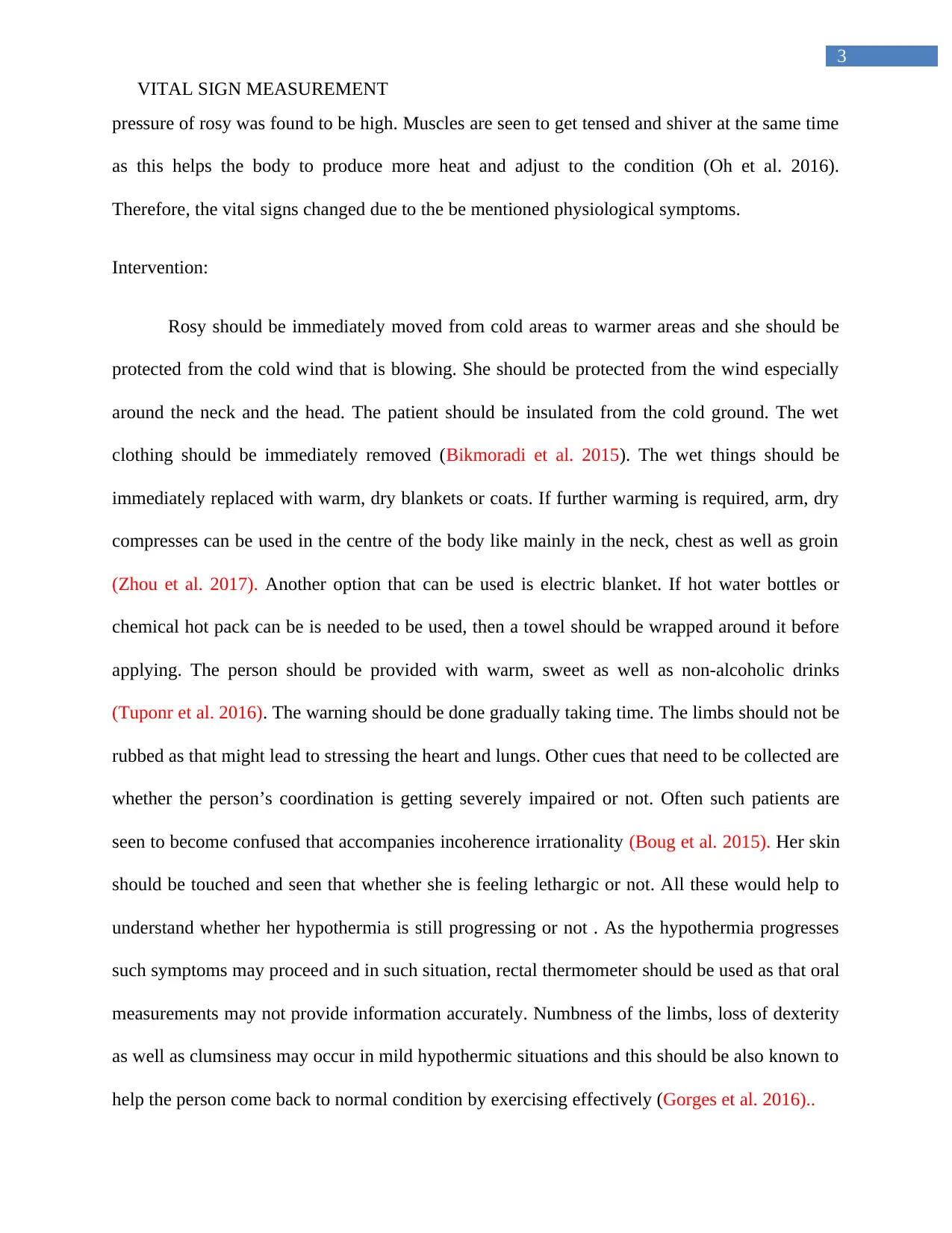
3
VITAL SIGN MEASUREMENT
pressure of rosy was found to be high. Muscles are seen to get tensed and shiver at the same time
as this helps the body to produce more heat and adjust to the condition (Oh et al. 2016).
Therefore, the vital signs changed due to the be mentioned physiological symptoms.
Intervention:
Rosy should be immediately moved from cold areas to warmer areas and she should be
protected from the cold wind that is blowing. She should be protected from the wind especially
around the neck and the head. The patient should be insulated from the cold ground. The wet
clothing should be immediately removed (Bikmoradi et al. 2015). The wet things should be
immediately replaced with warm, dry blankets or coats. If further warming is required, arm, dry
compresses can be used in the centre of the body like mainly in the neck, chest as well as groin
(Zhou et al. 2017). Another option that can be used is electric blanket. If hot water bottles or
chemical hot pack can be is needed to be used, then a towel should be wrapped around it before
applying. The person should be provided with warm, sweet as well as non-alcoholic drinks
(Tuponr et al. 2016). The warning should be done gradually taking time. The limbs should not be
rubbed as that might lead to stressing the heart and lungs. Other cues that need to be collected are
whether the person’s coordination is getting severely impaired or not. Often such patients are
seen to become confused that accompanies incoherence irrationality (Boug et al. 2015). Her skin
should be touched and seen that whether she is feeling lethargic or not. All these would help to
understand whether her hypothermia is still progressing or not . As the hypothermia progresses
such symptoms may proceed and in such situation, rectal thermometer should be used as that oral
measurements may not provide information accurately. Numbness of the limbs, loss of dexterity
as well as clumsiness may occur in mild hypothermic situations and this should be also known to
help the person come back to normal condition by exercising effectively (Gorges et al. 2016)..
VITAL SIGN MEASUREMENT
pressure of rosy was found to be high. Muscles are seen to get tensed and shiver at the same time
as this helps the body to produce more heat and adjust to the condition (Oh et al. 2016).
Therefore, the vital signs changed due to the be mentioned physiological symptoms.
Intervention:
Rosy should be immediately moved from cold areas to warmer areas and she should be
protected from the cold wind that is blowing. She should be protected from the wind especially
around the neck and the head. The patient should be insulated from the cold ground. The wet
clothing should be immediately removed (Bikmoradi et al. 2015). The wet things should be
immediately replaced with warm, dry blankets or coats. If further warming is required, arm, dry
compresses can be used in the centre of the body like mainly in the neck, chest as well as groin
(Zhou et al. 2017). Another option that can be used is electric blanket. If hot water bottles or
chemical hot pack can be is needed to be used, then a towel should be wrapped around it before
applying. The person should be provided with warm, sweet as well as non-alcoholic drinks
(Tuponr et al. 2016). The warning should be done gradually taking time. The limbs should not be
rubbed as that might lead to stressing the heart and lungs. Other cues that need to be collected are
whether the person’s coordination is getting severely impaired or not. Often such patients are
seen to become confused that accompanies incoherence irrationality (Boug et al. 2015). Her skin
should be touched and seen that whether she is feeling lethargic or not. All these would help to
understand whether her hypothermia is still progressing or not . As the hypothermia progresses
such symptoms may proceed and in such situation, rectal thermometer should be used as that oral
measurements may not provide information accurately. Numbness of the limbs, loss of dexterity
as well as clumsiness may occur in mild hypothermic situations and this should be also known to
help the person come back to normal condition by exercising effectively (Gorges et al. 2016)..
Paraphrase This Document
Need a fresh take? Get an instant paraphrase of this document with our AI Paraphraser
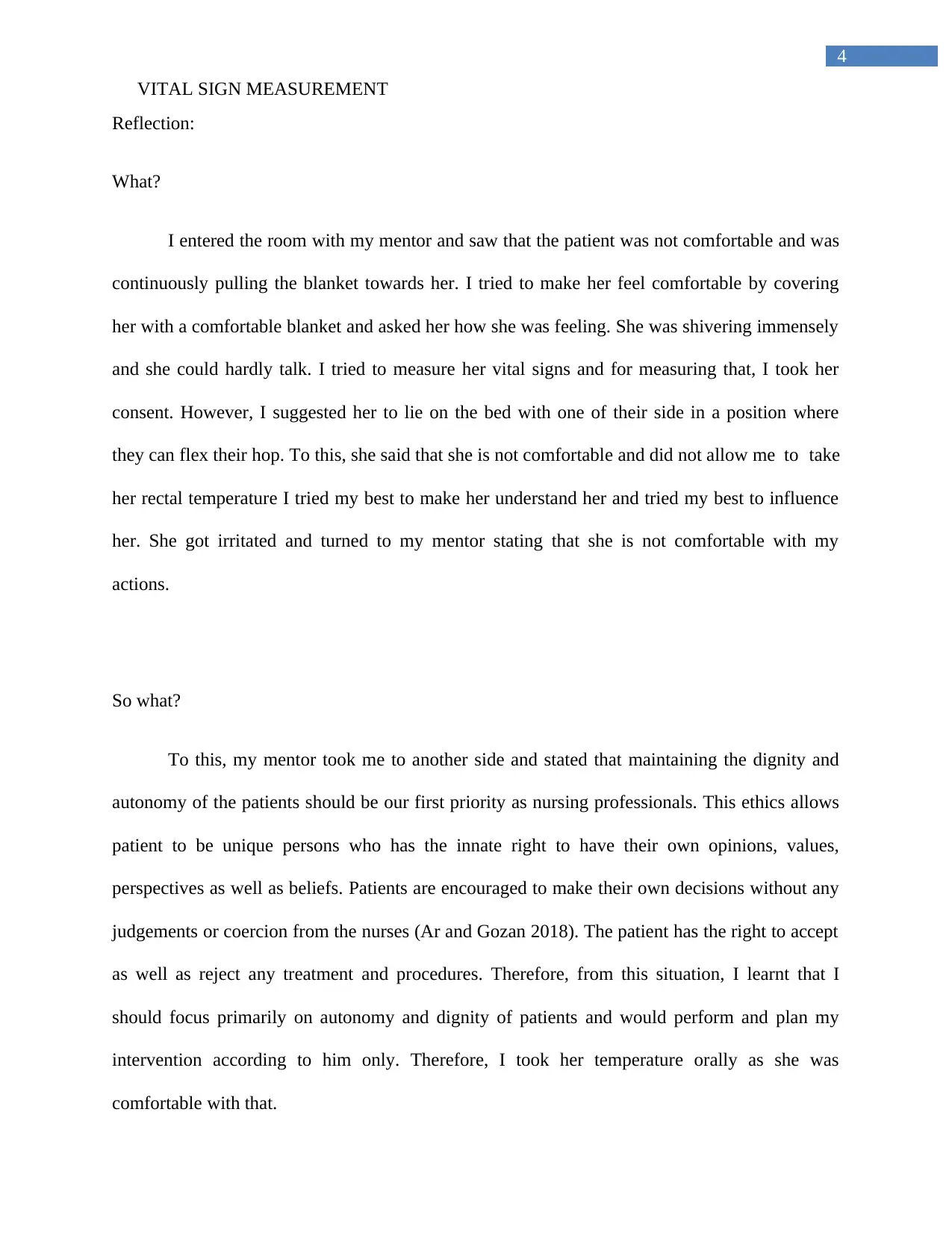
4
VITAL SIGN MEASUREMENT
Reflection:
What?
I entered the room with my mentor and saw that the patient was not comfortable and was
continuously pulling the blanket towards her. I tried to make her feel comfortable by covering
her with a comfortable blanket and asked her how she was feeling. She was shivering immensely
and she could hardly talk. I tried to measure her vital signs and for measuring that, I took her
consent. However, I suggested her to lie on the bed with one of their side in a position where
they can flex their hop. To this, she said that she is not comfortable and did not allow me to take
her rectal temperature I tried my best to make her understand her and tried my best to influence
her. She got irritated and turned to my mentor stating that she is not comfortable with my
actions.
So what?
To this, my mentor took me to another side and stated that maintaining the dignity and
autonomy of the patients should be our first priority as nursing professionals. This ethics allows
patient to be unique persons who has the innate right to have their own opinions, values,
perspectives as well as beliefs. Patients are encouraged to make their own decisions without any
judgements or coercion from the nurses (Ar and Gozan 2018). The patient has the right to accept
as well as reject any treatment and procedures. Therefore, from this situation, I learnt that I
should focus primarily on autonomy and dignity of patients and would perform and plan my
intervention according to him only. Therefore, I took her temperature orally as she was
comfortable with that.
VITAL SIGN MEASUREMENT
Reflection:
What?
I entered the room with my mentor and saw that the patient was not comfortable and was
continuously pulling the blanket towards her. I tried to make her feel comfortable by covering
her with a comfortable blanket and asked her how she was feeling. She was shivering immensely
and she could hardly talk. I tried to measure her vital signs and for measuring that, I took her
consent. However, I suggested her to lie on the bed with one of their side in a position where
they can flex their hop. To this, she said that she is not comfortable and did not allow me to take
her rectal temperature I tried my best to make her understand her and tried my best to influence
her. She got irritated and turned to my mentor stating that she is not comfortable with my
actions.
So what?
To this, my mentor took me to another side and stated that maintaining the dignity and
autonomy of the patients should be our first priority as nursing professionals. This ethics allows
patient to be unique persons who has the innate right to have their own opinions, values,
perspectives as well as beliefs. Patients are encouraged to make their own decisions without any
judgements or coercion from the nurses (Ar and Gozan 2018). The patient has the right to accept
as well as reject any treatment and procedures. Therefore, from this situation, I learnt that I
should focus primarily on autonomy and dignity of patients and would perform and plan my
intervention according to him only. Therefore, I took her temperature orally as she was
comfortable with that.
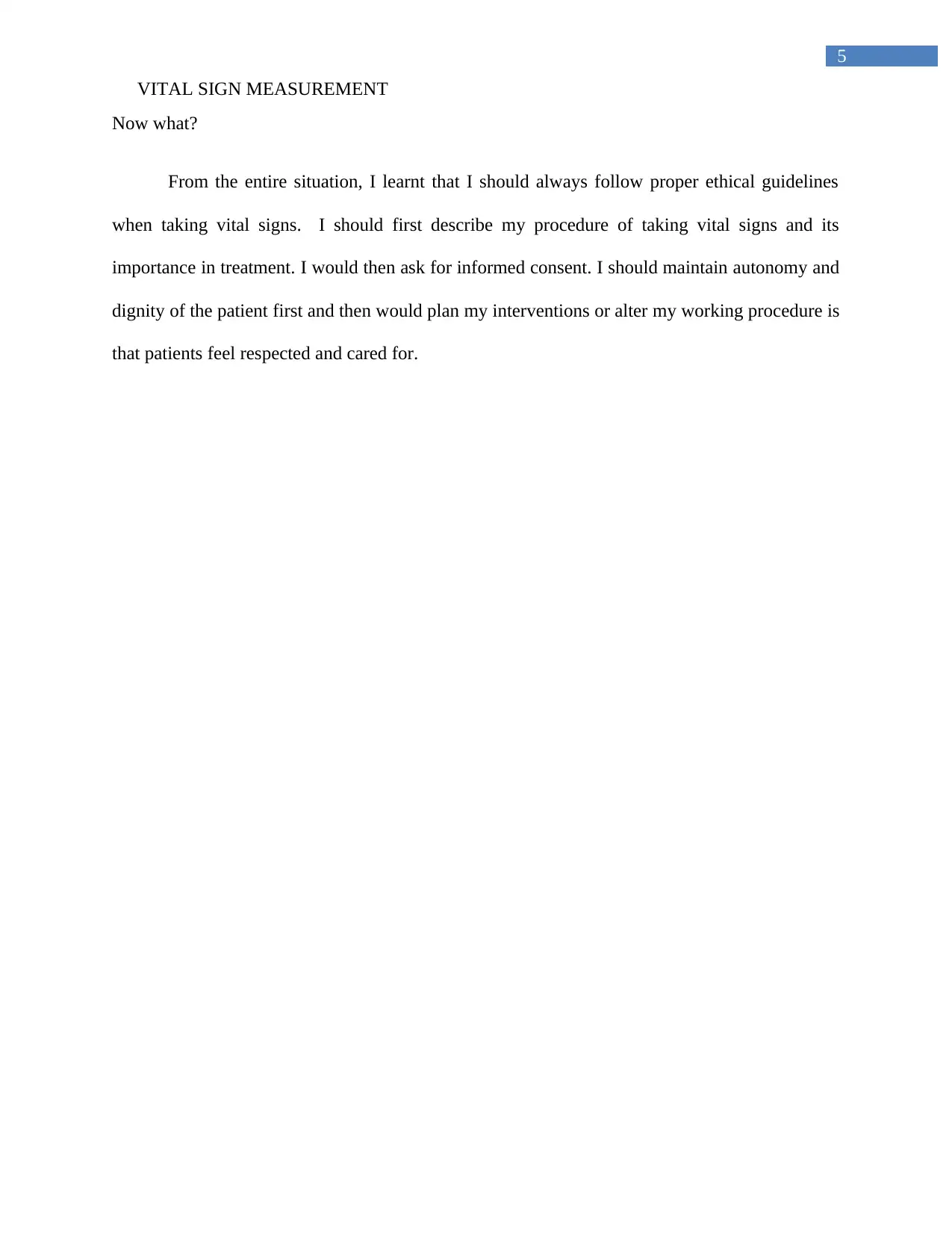
5
VITAL SIGN MEASUREMENT
Now what?
From the entire situation, I learnt that I should always follow proper ethical guidelines
when taking vital signs. I should first describe my procedure of taking vital signs and its
importance in treatment. I would then ask for informed consent. I should maintain autonomy and
dignity of the patient first and then would plan my interventions or alter my working procedure is
that patients feel respected and cared for.
VITAL SIGN MEASUREMENT
Now what?
From the entire situation, I learnt that I should always follow proper ethical guidelines
when taking vital signs. I should first describe my procedure of taking vital signs and its
importance in treatment. I would then ask for informed consent. I should maintain autonomy and
dignity of the patient first and then would plan my interventions or alter my working procedure is
that patients feel respected and cared for.
⊘ This is a preview!⊘
Do you want full access?
Subscribe today to unlock all pages.

Trusted by 1+ million students worldwide
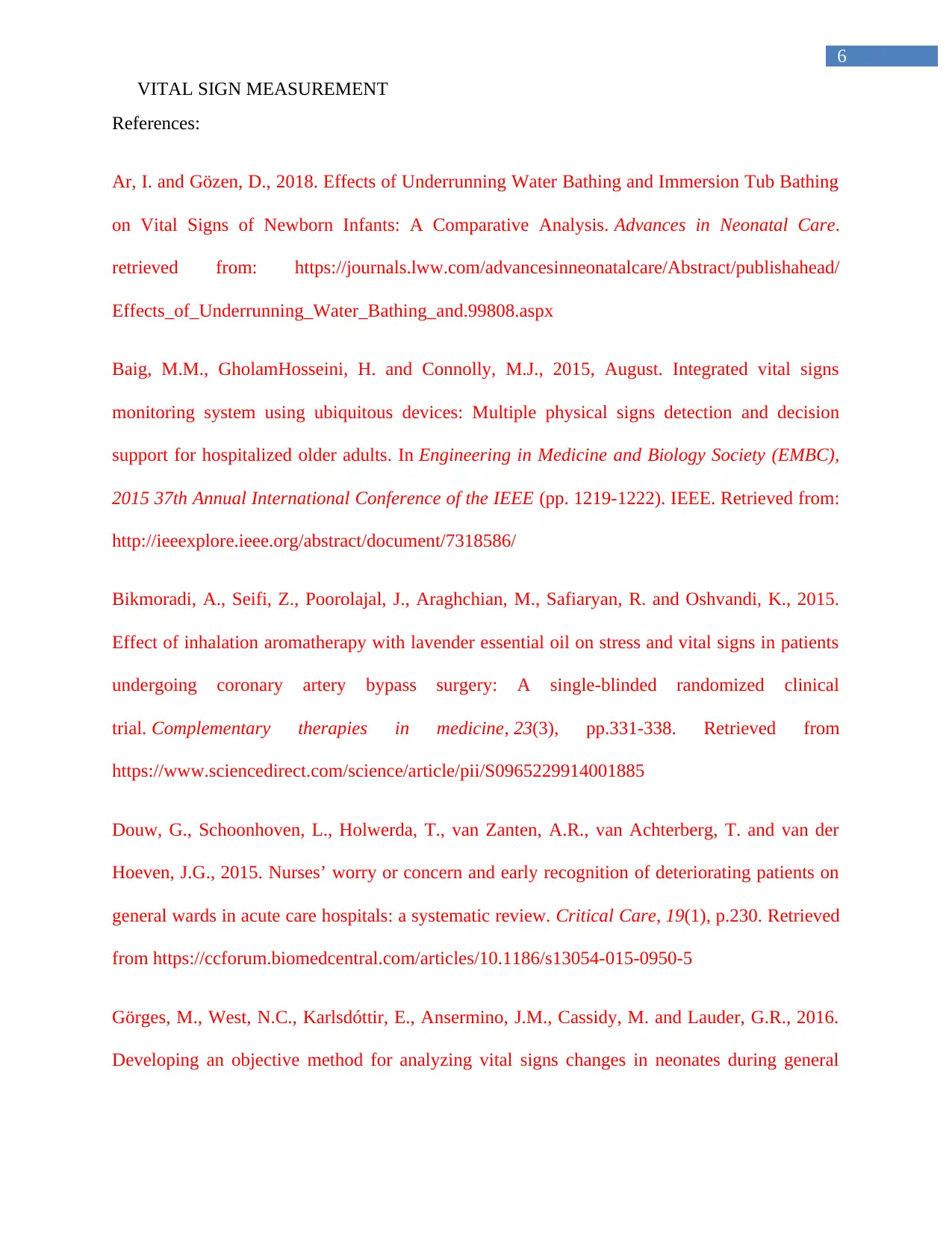
6
VITAL SIGN MEASUREMENT
References:
Ar, I. and Gözen, D., 2018. Effects of Underrunning Water Bathing and Immersion Tub Bathing
on Vital Signs of Newborn Infants: A Comparative Analysis. Advances in Neonatal Care.
retrieved from: https://journals.lww.com/advancesinneonatalcare/Abstract/publishahead/
Effects_of_Underrunning_Water_Bathing_and.99808.aspx
Baig, M.M., GholamHosseini, H. and Connolly, M.J., 2015, August. Integrated vital signs
monitoring system using ubiquitous devices: Multiple physical signs detection and decision
support for hospitalized older adults. In Engineering in Medicine and Biology Society (EMBC),
2015 37th Annual International Conference of the IEEE (pp. 1219-1222). IEEE. Retrieved from:
http://ieeexplore.ieee.org/abstract/document/7318586/
Bikmoradi, A., Seifi, Z., Poorolajal, J., Araghchian, M., Safiaryan, R. and Oshvandi, K., 2015.
Effect of inhalation aromatherapy with lavender essential oil on stress and vital signs in patients
undergoing coronary artery bypass surgery: A single-blinded randomized clinical
trial. Complementary therapies in medicine, 23(3), pp.331-338. Retrieved from
https://www.sciencedirect.com/science/article/pii/S0965229914001885
Douw, G., Schoonhoven, L., Holwerda, T., van Zanten, A.R., van Achterberg, T. and van der
Hoeven, J.G., 2015. Nurses’ worry or concern and early recognition of deteriorating patients on
general wards in acute care hospitals: a systematic review. Critical Care, 19(1), p.230. Retrieved
from https://ccforum.biomedcentral.com/articles/10.1186/s13054-015-0950-5
Görges, M., West, N.C., Karlsdóttir, E., Ansermino, J.M., Cassidy, M. and Lauder, G.R., 2016.
Developing an objective method for analyzing vital signs changes in neonates during general
VITAL SIGN MEASUREMENT
References:
Ar, I. and Gözen, D., 2018. Effects of Underrunning Water Bathing and Immersion Tub Bathing
on Vital Signs of Newborn Infants: A Comparative Analysis. Advances in Neonatal Care.
retrieved from: https://journals.lww.com/advancesinneonatalcare/Abstract/publishahead/
Effects_of_Underrunning_Water_Bathing_and.99808.aspx
Baig, M.M., GholamHosseini, H. and Connolly, M.J., 2015, August. Integrated vital signs
monitoring system using ubiquitous devices: Multiple physical signs detection and decision
support for hospitalized older adults. In Engineering in Medicine and Biology Society (EMBC),
2015 37th Annual International Conference of the IEEE (pp. 1219-1222). IEEE. Retrieved from:
http://ieeexplore.ieee.org/abstract/document/7318586/
Bikmoradi, A., Seifi, Z., Poorolajal, J., Araghchian, M., Safiaryan, R. and Oshvandi, K., 2015.
Effect of inhalation aromatherapy with lavender essential oil on stress and vital signs in patients
undergoing coronary artery bypass surgery: A single-blinded randomized clinical
trial. Complementary therapies in medicine, 23(3), pp.331-338. Retrieved from
https://www.sciencedirect.com/science/article/pii/S0965229914001885
Douw, G., Schoonhoven, L., Holwerda, T., van Zanten, A.R., van Achterberg, T. and van der
Hoeven, J.G., 2015. Nurses’ worry or concern and early recognition of deteriorating patients on
general wards in acute care hospitals: a systematic review. Critical Care, 19(1), p.230. Retrieved
from https://ccforum.biomedcentral.com/articles/10.1186/s13054-015-0950-5
Görges, M., West, N.C., Karlsdóttir, E., Ansermino, J.M., Cassidy, M. and Lauder, G.R., 2016.
Developing an objective method for analyzing vital signs changes in neonates during general
Paraphrase This Document
Need a fresh take? Get an instant paraphrase of this document with our AI Paraphraser
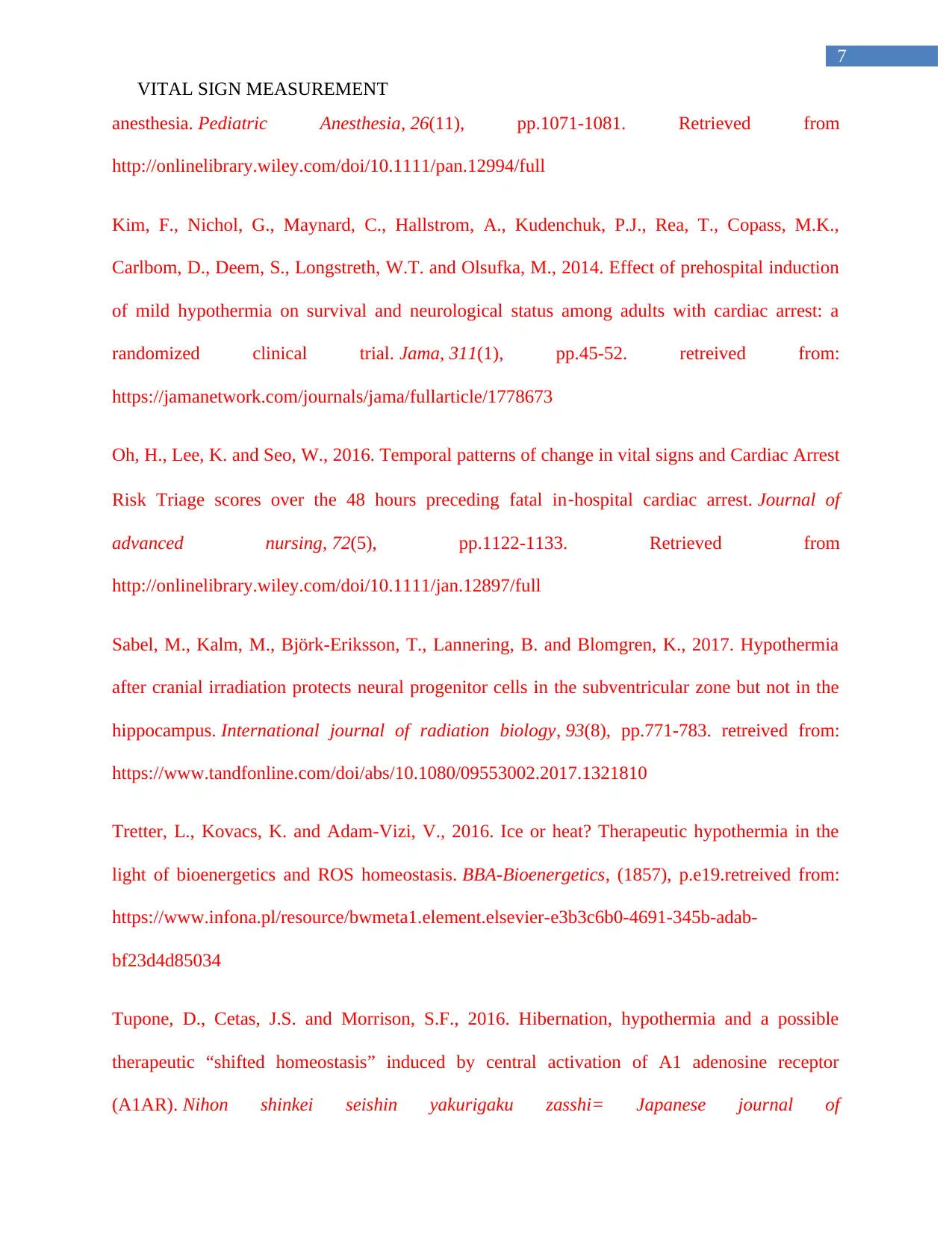
7
VITAL SIGN MEASUREMENT
anesthesia. Pediatric Anesthesia, 26(11), pp.1071-1081. Retrieved from
http://onlinelibrary.wiley.com/doi/10.1111/pan.12994/full
Kim, F., Nichol, G., Maynard, C., Hallstrom, A., Kudenchuk, P.J., Rea, T., Copass, M.K.,
Carlbom, D., Deem, S., Longstreth, W.T. and Olsufka, M., 2014. Effect of prehospital induction
of mild hypothermia on survival and neurological status among adults with cardiac arrest: a
randomized clinical trial. Jama, 311(1), pp.45-52. retreived from:
https://jamanetwork.com/journals/jama/fullarticle/1778673
Oh, H., Lee, K. and Seo, W., 2016. Temporal patterns of change in vital signs and Cardiac Arrest
Risk Triage scores over the 48 hours preceding fatal in‐hospital cardiac arrest. Journal of
advanced nursing, 72(5), pp.1122-1133. Retrieved from
http://onlinelibrary.wiley.com/doi/10.1111/jan.12897/full
Sabel, M., Kalm, M., Björk-Eriksson, T., Lannering, B. and Blomgren, K., 2017. Hypothermia
after cranial irradiation protects neural progenitor cells in the subventricular zone but not in the
hippocampus. International journal of radiation biology, 93(8), pp.771-783. retreived from:
https://www.tandfonline.com/doi/abs/10.1080/09553002.2017.1321810
Tretter, L., Kovacs, K. and Adam-Vizi, V., 2016. Ice or heat? Therapeutic hypothermia in the
light of bioenergetics and ROS homeostasis. BBA-Bioenergetics, (1857), p.e19.retreived from:
https://www.infona.pl/resource/bwmeta1.element.elsevier-e3b3c6b0-4691-345b-adab-
bf23d4d85034
Tupone, D., Cetas, J.S. and Morrison, S.F., 2016. Hibernation, hypothermia and a possible
therapeutic “shifted homeostasis” induced by central activation of A1 adenosine receptor
(A1AR). Nihon shinkei seishin yakurigaku zasshi= Japanese journal of
VITAL SIGN MEASUREMENT
anesthesia. Pediatric Anesthesia, 26(11), pp.1071-1081. Retrieved from
http://onlinelibrary.wiley.com/doi/10.1111/pan.12994/full
Kim, F., Nichol, G., Maynard, C., Hallstrom, A., Kudenchuk, P.J., Rea, T., Copass, M.K.,
Carlbom, D., Deem, S., Longstreth, W.T. and Olsufka, M., 2014. Effect of prehospital induction
of mild hypothermia on survival and neurological status among adults with cardiac arrest: a
randomized clinical trial. Jama, 311(1), pp.45-52. retreived from:
https://jamanetwork.com/journals/jama/fullarticle/1778673
Oh, H., Lee, K. and Seo, W., 2016. Temporal patterns of change in vital signs and Cardiac Arrest
Risk Triage scores over the 48 hours preceding fatal in‐hospital cardiac arrest. Journal of
advanced nursing, 72(5), pp.1122-1133. Retrieved from
http://onlinelibrary.wiley.com/doi/10.1111/jan.12897/full
Sabel, M., Kalm, M., Björk-Eriksson, T., Lannering, B. and Blomgren, K., 2017. Hypothermia
after cranial irradiation protects neural progenitor cells in the subventricular zone but not in the
hippocampus. International journal of radiation biology, 93(8), pp.771-783. retreived from:
https://www.tandfonline.com/doi/abs/10.1080/09553002.2017.1321810
Tretter, L., Kovacs, K. and Adam-Vizi, V., 2016. Ice or heat? Therapeutic hypothermia in the
light of bioenergetics and ROS homeostasis. BBA-Bioenergetics, (1857), p.e19.retreived from:
https://www.infona.pl/resource/bwmeta1.element.elsevier-e3b3c6b0-4691-345b-adab-
bf23d4d85034
Tupone, D., Cetas, J.S. and Morrison, S.F., 2016. Hibernation, hypothermia and a possible
therapeutic “shifted homeostasis” induced by central activation of A1 adenosine receptor
(A1AR). Nihon shinkei seishin yakurigaku zasshi= Japanese journal of
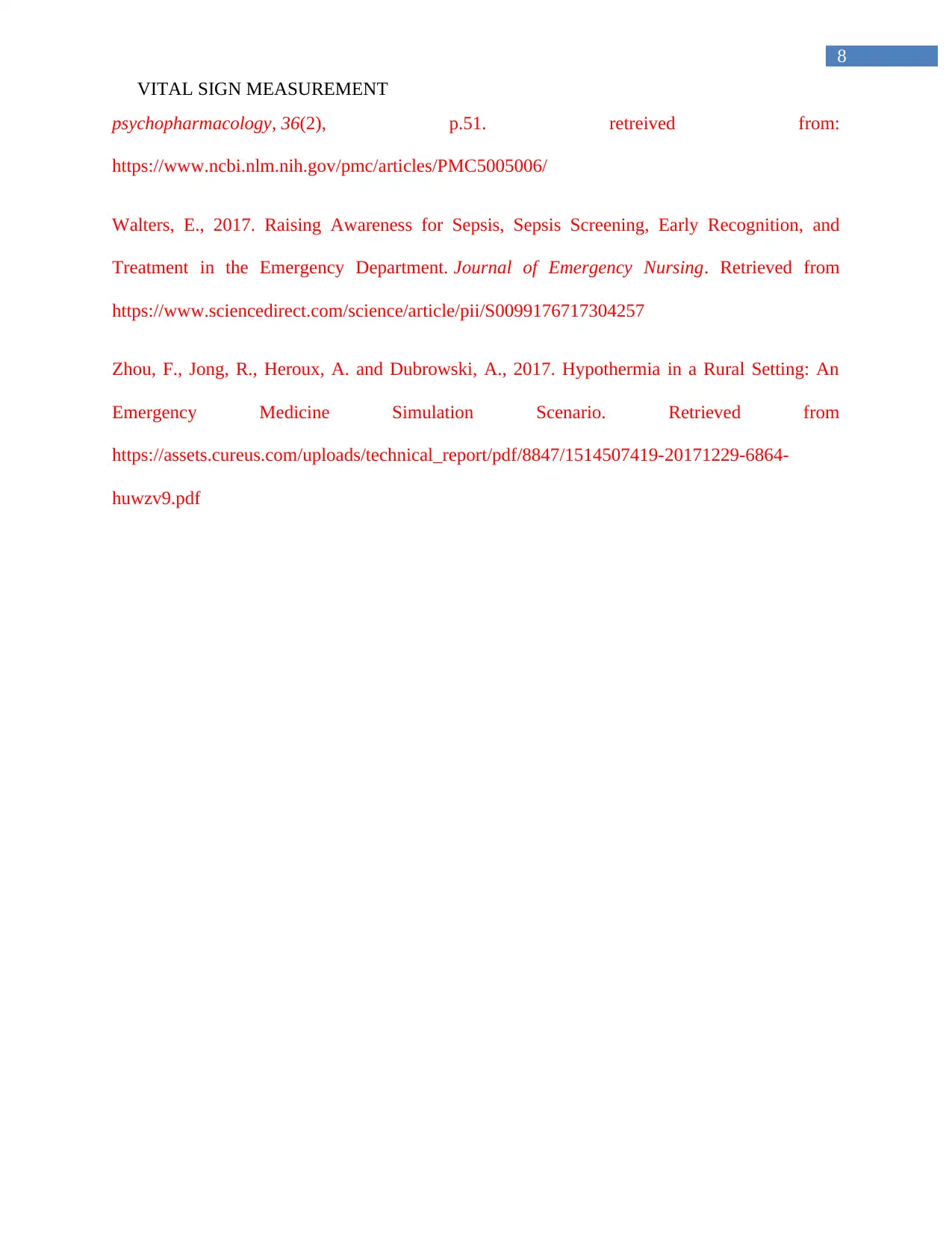
8
VITAL SIGN MEASUREMENT
psychopharmacology, 36(2), p.51. retreived from:
https://www.ncbi.nlm.nih.gov/pmc/articles/PMC5005006/
Walters, E., 2017. Raising Awareness for Sepsis, Sepsis Screening, Early Recognition, and
Treatment in the Emergency Department. Journal of Emergency Nursing. Retrieved from
https://www.sciencedirect.com/science/article/pii/S0099176717304257
Zhou, F., Jong, R., Heroux, A. and Dubrowski, A., 2017. Hypothermia in a Rural Setting: An
Emergency Medicine Simulation Scenario. Retrieved from
https://assets.cureus.com/uploads/technical_report/pdf/8847/1514507419-20171229-6864-
huwzv9.pdf
VITAL SIGN MEASUREMENT
psychopharmacology, 36(2), p.51. retreived from:
https://www.ncbi.nlm.nih.gov/pmc/articles/PMC5005006/
Walters, E., 2017. Raising Awareness for Sepsis, Sepsis Screening, Early Recognition, and
Treatment in the Emergency Department. Journal of Emergency Nursing. Retrieved from
https://www.sciencedirect.com/science/article/pii/S0099176717304257
Zhou, F., Jong, R., Heroux, A. and Dubrowski, A., 2017. Hypothermia in a Rural Setting: An
Emergency Medicine Simulation Scenario. Retrieved from
https://assets.cureus.com/uploads/technical_report/pdf/8847/1514507419-20171229-6864-
huwzv9.pdf
⊘ This is a preview!⊘
Do you want full access?
Subscribe today to unlock all pages.

Trusted by 1+ million students worldwide
1 out of 9
Related Documents
Your All-in-One AI-Powered Toolkit for Academic Success.
+13062052269
info@desklib.com
Available 24*7 on WhatsApp / Email
![[object Object]](/_next/static/media/star-bottom.7253800d.svg)
Unlock your academic potential
Copyright © 2020–2025 A2Z Services. All Rights Reserved. Developed and managed by ZUCOL.





